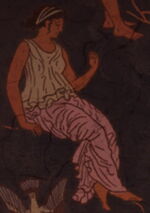
Ariadne was a Kretan princess, the daughter of King Minos, and the goddess of the labyrinth, mazes and snakes in Greek mythology. She was also the sister of Phaidra, and the half-sister of the Minotaur.
Biography
In Greek legends, Ariadne met the Athenian Theseus when he arrived in Krete,[1] as per King Minos' command to the Athenians to send fourteen of their finest men and women annually to feed to the Minotaur in the labyrinth below the Knossos Palace.[2]
They fell in love, and Ariadne gave Theseus thread to help him find his way in the labyrinth. After Theseus' success, Ariadne joined him on his ship, and they set sail for Athens together.[1] However, they stopped at Naxos Island to celebrate. Theseus left the island alone, either because he abandoned Ariadne, or because she forgot to return to his ship in time.[1][3]
On Naxos, Ariadne was eventually killed by the huntress goddess Artemis for defiling a sacred place dedicated to her.[3]
Legacy and influence
An alleged deathbed was attributed to Ariande and in the 5th century BCE, was visited by the Spartan misthios Kassandra during the Peloponnesian War.[4]
Trivia
- In most mythical accounts, Ariadne was not killed by Artemis on Naxos. Instead, she was wedded by Dionysos and thus became immortal.
- The mural featuring Ariadne is based on a reconstruction of Polygnotos' Nekyia.
Gallery
Appearances
- Assassin's Creed: Odyssey (first mentioned)
- Discovery Tour: Ancient Greece (mentioned only)
References
- ↑ 1.0 1.1 1.2 Discovery Tour: Ancient Greece – Tours: Knossos: "The Minotaur's Death"
- ↑ Discovery Tour: Ancient Greece – Tours: Knossos: "Reparation"
- ↑ 3.0 3.1 Assassin's Creed: Odyssey – Historical Locations: "Naxos: Deathbed of Ariadne"
- ↑ Assassin's Creed: Odyssey
